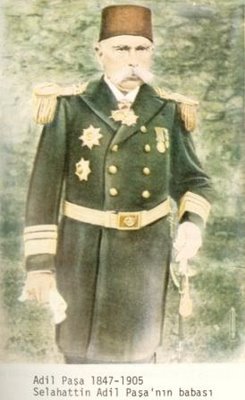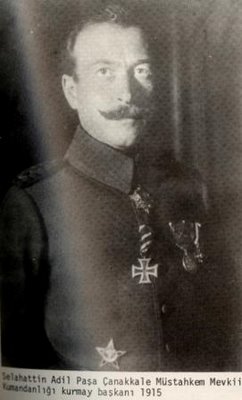Sunday, November 05, 2006
YOUNG ARTILLERY OFFICER SELAHATTIN ADIL IN DAMASCUS (1906)

THIS PICTURE WAS TAKEN WHILE HE WAS SERVING IN THE FIFTH IMPERIAL ARMY, IN DAMASCUS. HIS ASSIGNMENT WAS RELATED TO THE ISTANBUL-HEDJAZ RAILWAY CONTRUCTION. THIS RAILROAD LINE WAS CROSSING TODAY'S TURKEY, SYRIA, JORDAN, SAUDI ARABIA. THIS CONSTRUCTION WAS IMPORTANT FOR THE EMPIRE BECAUSE THE SULTAN WAS AIMING TO INCREASE HIS CONTROL OVER THE MIDDLE EASTERN TERRITORIES OF THE EMPIRE BY BUILDING RAILWAYS AND TELEGRAPH LINES. APART FROM THE ADMINISTRATIVE FUNCTIONS THIS RAILWAY HAD ALSO MILITARY AND RELIGIOUS FUNCTIONS.
THE YOUNG ARTILLERY OFFICER OF THE IMPERIAL ARMY, SELAHATTIN ADIL IN BUCHAREST, ROMANIA, AS THE MILITARY ATTACHE OF THE OTTOMAN EMPIRE (1911)

HERE WE SEE HIM AS THE MILITARY ATTACHE OF THE OTTOMAN EMPIRE IN BUCHAREST (1911), JUST BEFORE THE BALKAN WARS.
AFTER THIS ASSIGNMENT, HE MOVED TO LIBYA IN 1912, TO PARTICIPATE IN THE TRABLUSGARB WAR AGAINST THE ITALIANS WHO WERE AIMING TO TAKE THIS REGION FROM THE OTTOMANS, AND TURN IT INTO AN ITALIAN COLONY. HE ORGANIZED SOME COVERED OPERATIONS TO SMUGGLE ARMS FOR THE LOCALS, AND OTHER OTTOMAN OFFICERS WHO ARRIVED TO ORGANIZE THE RESISTANCE IN LIBYA.
SELAHATTIN ADIL, THE COMMANDER OF THE FORTIFIED LINES & THE ARTILLERY AT THE DARDANELLES ON THE DAY OF THE ALLIED NAVY ASSAULT (18 MARCH 1915)

The naval operations in the Dardanelles Campaign of the First World War were mainly carried out by the Royal Navy with substantial support from the French and minor contributions from Russia and Australia. The Dardanelles Campaign began as a purely naval operation and, after the amphibious invasion of the Gallipoli peninsula, naval forces were heavily involved in supporting the ground troops. Throughout the campaign, attempts were made by submarines to pass through the Dardanelles and disrupt Ottoman Empire shipping in the Sea of Marmara.The Dardanelles were defended by a system of fortified and mobile artillery arranged as the "Outer", "Intermediate" and "Inner" defences. While the outer defences lay at the entrance to the straits and would prove vulnerable to bombardment and raiding, the inner defences covered the Narrows, the narrowest point of the straits near Çanakkale. Beyond the inner defences, the straits were virtually undefended. However, the foundation of the straits defences were a series of 10 minefields, laid across the straits near the Narrows and containing a total of 370 mines.
The event that decided the battle for the Dardanelles took place on the night of March 18 when the Turkish minelayer Nusrat laid a line of mines in Eren Keui Bay, a wide bay along the Asian shore just inside the entrance to the straits. The Turks had noticed the British ships turned to starboard into the bay when withdrawing. The new line of between 20 and 26 mines ran parallel to the shore, were moored at 2.5 fathoms (4.5 m) and spaced about 100 yards or meters apart. The British plan for March 18 was to silence the defences guarding the first five lines of mines which would be cleared overnight by the minesweepers. The next day the remaining defences around the Narrows would be defeated and the last five minefields would be cleared. The battleships were arranged in three lines, two British and one French, with supporting ships on the flanks and two ships in reserve.
The first British line opened fire from Eren Keui Bay around 11am. Shortly after noon, de Robeck ordered the French line to pass through and close on the Narrows forts. The Turkish fire began to take its toll with Gaulois, Suffren, Agamemnon and Inflexible all suffering hits. While the naval fire had not destroyed the Turkish batteries, it had succeeded in temporarily reducing their fire. By 1.25pm the Turkish defences were mostly silent so de Robeck decided to withdraw the French line and bring forward the second British line as well as Swiftsure and Majestic. At 1.54pm Bouvet, having made a turn to starboard into Eren Keui Bay, struck a mine, capsized and sank within a couple of minutes, killing 600 men. The initial British reaction was that a shell had struck her magazine or she had been torpedoed. Most reports state that they remained unaware of the minefield, however mines in the string had ben spotted earlier that morning, and their sighting relayed to Admiral Robeck. No action was taken to protect the battleships.
The British pressed on with the attack. Around 4pm Inflexible began to withdraw and struck a mine near where Bouvet went down, killing 30 men. The battlecruiser remained afloat and eventually beached on the island of Tenedos. Irresistible was the next to be mined. As she began to drift helplessly, the crew were taken off. De Robeck told Ocean to take Irresistible under tow but the water was deemed to shallow to make an approach. Finally at 6.05pm Ocean struck a mine which jammed the steering gear leaving her likewise helpless. The abandoned battleships were still floating when the British withdrew. A destroyer returned later to torpedo the stricken vessels but despite searching for four hours, there was no sign of them. March 18 was a significant victory for Turkey. Nevertheless, there were calls amongst the British to press on with the naval attack, and de Robeck initially planned to do so after several days. With the exception of the Inflexible, the ships that were lost or damaged were old, ill-equipped for modern naval combat and, in the eyes of some, expendable. There have been theories that the Turkish forts had nearly exhausted their ammunition so that if the naval attack had resumed, the Allies would have met little opposition. Moreover the crews of the sunken battleships were replaced the civilians on the trawler minesweepers, making them much more willing to keep sweeping under fire, and the fleet had several modern destroyers fitted with 1 1/2" minesweeping hawsers that could have handled the task with ease.
De Robeck was reported to be distraught from the losses, his intention to continue the attack as above not withstanding, and it is possible that he was overwhelmed by the scale of the loss - he had been in charge of a fleet that had suffered the most serious loss to the Royal Navy since Trafalgar. However, the failure of the March 18 attack led to a plan to use infantry to neutralise the forts.
 Yillar sonra, Harbiye'de bir konferansda konuşmacı olarak kürsüye gelen Selahattin Adil Paşa 18 Mart Zaferini tüm ayrıntılarıyla anlatır. O esnada salonda deniz savaşı uzmanı ayni zamanda Abidin Daver de vardır. Konferans sonrası ayağa kalkarak şöyle der:“Kusura bakmayın. Selahattin Adil Paşa çok güzel anlattı. Dinleyenler paşanın gazeteci olduğunu ya da savaşta seyirci olarak bulunduğunu sanabilirler. Kendisi, o günü idare eden ve kazandıran insandı. İşte o zaman paşanın öz oğlu babasının Çanakkale’de çarpıştığını öğrenir. O abidevi şahsiyet çocuklarına savaştığını bile söylememiştir. Salonda büyük bir alkış tufanı kopar...”
Yillar sonra, Harbiye'de bir konferansda konuşmacı olarak kürsüye gelen Selahattin Adil Paşa 18 Mart Zaferini tüm ayrıntılarıyla anlatır. O esnada salonda deniz savaşı uzmanı ayni zamanda Abidin Daver de vardır. Konferans sonrası ayağa kalkarak şöyle der:“Kusura bakmayın. Selahattin Adil Paşa çok güzel anlattı. Dinleyenler paşanın gazeteci olduğunu ya da savaşta seyirci olarak bulunduğunu sanabilirler. Kendisi, o günü idare eden ve kazandıran insandı. İşte o zaman paşanın öz oğlu babasının Çanakkale’de çarpıştığını öğrenir. O abidevi şahsiyet çocuklarına savaştığını bile söylememiştir. Salonda büyük bir alkış tufanı kopar...”
Zaferde büyük payı olan kişinin tevazuu da bir o kadar büyüktür. Bunu kendi hatıratında daha net belirtir. Zaferin millete ait olduğunu söyler:
“Amiral De Robeck'in saat 16.30’da bütün donanması ile girişe doğru çekilmeye başladığını görerek geniş ve rahat bir nefes aldık. Kalbimiz, Allah’ın milletimize sağladığı bu önemli başarıdan dolayı minnet ve şükran duyguları ile dolu olarak hava kararırken karargâhımıza döndük. Ancak gerçek düşünülecek olursa, bu ve bunun gibi başarılar, kişilerin rolleri ne olursa olsun katılanların, müşterek eseridir. Bunda şüphesiz en büyük pay ise, en ağır ve en tehlikeli durumlar karşısında kutsal vatan için hayatını feda edinceye kadar büyük bir sükûn ve alçak gönüllülük içinde görevlerini yapan şehitlerimize aittir. Biz idareciler zaten eğitim ve öğrenimimizi, yetiştirilmemizi, rütbe ve mevkilere yükselmemizi, sırasında bir makine gibi kullandığımız bu fedakâr millete borçlu değil miyiz? Bu gibi milletçe kazanılmış zaferler milletin malıdır, milletin bütününe aittir”
(SELAHATTIN ADIL, HAYAT MUCADELELERI, ISTANBUL, 1982)
As it can be seen in the picture, Selahattin Adil received his iron cross as many Turkish officers during the First World War. For a complete list of Turkish Officers with Iron Cross, please visit the web page below:
http://forum.axishistory.com/viewtopic.php?t=105327&highlight=turkish+iron+cross
SELAHATTIN ADIL PASHA, AS THE COMMANDER IN THE ARMY OF THE GRAND NATIONAL ASSEMBLY OF TURKEY IN ANKARA
 THE LEADING FIGURES OF THE TURKISH GOVERNMENT IN ANKARA, WHO RESISTED AGAINST THE INTERVENTIONS AND OCCUPATIONS OF THE ALLIED ARMIES, AND MOREOVER UPRISED AGAINST THE SULTAN IN ISTANBUL.
THE LEADING FIGURES OF THE TURKISH GOVERNMENT IN ANKARA, WHO RESISTED AGAINST THE INTERVENTIONS AND OCCUPATIONS OF THE ALLIED ARMIES, AND MOREOVER UPRISED AGAINST THE SULTAN IN ISTANBUL.
SELAHATTIN ADIL PASHA IS THIRD FROM THE LEFT, AT THE SECOND ROW.
THE TOP FIGURE IN THIS POSTER IS MUSTAFA KEMAL (ATATURK) AS THE HEAD OF THE TURKISH ARMY AND THE HEAD OF THE GOVERNMENT OF THE GRAND NATIONAL ASSEMBLY OF TURKEY. THE OTHERS ARE ALSO PROMINENT CIVILIANS AND MILITARY COMMANDERS OF THE PERIOD.
SELAHATTIN ADIL PASHA, AS THE ARMY COMMANDER, DURING THE WAR BETWEEN GREECE AND TURKEY IN 1922.
SELAHATTIN ADIL PASHA, FIRST ASSIGNED AS THE COMMANDER OF THE SOUTHERN FRONT, AGAINST THE FRENCH INTERVENTION AND OCCUPATION. HE ORGANIZED THE RESISTANCE OF THE NATIONAL FORCES IN CILICIA REGION, (ADANA, TAURUS MOUNTAINS, ANTEP, URFA, AND MARAS) IN THE SOUTH, SOUTH-EASTERN TURKEY. AFTER THE WITHDRAWAL OF THE FRENCH FROM THAT REGION, ACCORDING TO THE FRANCO-TURKISH AGREEMENT OF THE 20th OCTOBER, 1921, HE WAS ASSIGNED BY THE PARLIAMENT IN ANKARA, TO PARTICIPATE IN THE GREAT ASSAULT AT THE WESTERN FRONT; CONSEQUENTLY, HE TOOK PART IN THE WAR AGAINST THE GREEKS. DURING THE KUTAHYA-ESKISEHIR BATTLES, HE WAS THE COMMANDER OF THE SOUTH FLANK OF THE WESTERN FRONT AND PROMOTED TO PASHA(BRIGADIER GENERAL). DURING THE SAKARYA BATTLE, HE WAS THE COMMANDER OF THE 2nd GROUP. LATER HE WAS APPOINTED TO THE COMMANDER OF THE 2nd ARMY.
WHILE ISTANBUL WAS UNDER THE ALLIED OCCUPATION, HE WAS ASSIGNED TO ISTANBUL AS THE COMMANDER OF THE CITY ON 23 NOVEMBER 1922. AS HIS SOLDIERS PARADED IN ISTANBUL, ALL CITY WAS ON THE STREETS. IN 1923 HE WAS PROMOTED TO THE MAJOR GENERAL, AND RETIRED FROM THE ARMY.
MAJOR GENERAL SELAHATTIN ADIL PASHA, AS THE COMMANDER OF ISTANBUL (1922-1923) DURING THOSE CRITICAL DAYS OF PEACE NEGOTIATIONS
ALL THESE PICTURES WERE TAKEN DURING THE PERIOD OF THE PEACE NEGOTIATIONS IN LAUSANNE, BETWEEN TURKEY AND THE ALLIES OF THE WWI. THE TURKISH ARMY EXPELLED THE GREEK FORCES FROM TURKEY, AND STATIONED AT THE ARMISTICE LINES SIGNED IN 1922, BUT THE WAR WAS NOT OVER; MOREOVER, ISTANBUL, STRAITS AND EUROPEAN PART OF TURKEY WERE STILL UNDER OCCUPATION. AT THIS MOMENT, TURKISH PARLIAMENT IN ANKARA, ASSIGNED SELAHATTIN ADIL PASHA AS THE TURKISH COMMANDER OF ISTANBUL.

SELAHATTIN ADIL PASHA WITH THE COMMANDERS OF THE OCCUPANT ARMIES IN ISTANBUL (1923)
(FROM LEFT TO RIGHT) THE COMMANDER OF THE ITALIAN FORCES, THE COMMANDER OF THE BRITISH FORCES, ADIL PASHA, THE COMMANDER OF THE FRENCH FORCES DURING THE HAND OVER.

MAJOR GENERAL SELAHATTIN ADIL PASHA, COMMANDER OF ISTANBUL, SEEING OFF THE COMMANDERS OF THE ALLIES TO THEIR COUNTRIES AT THE DOLMABAHCE PALACE (2 OCTOBER 1923)







 WITH HIS FAMILY IN ISTANBUL (1928).
WITH HIS FAMILY IN ISTANBUL (1928).